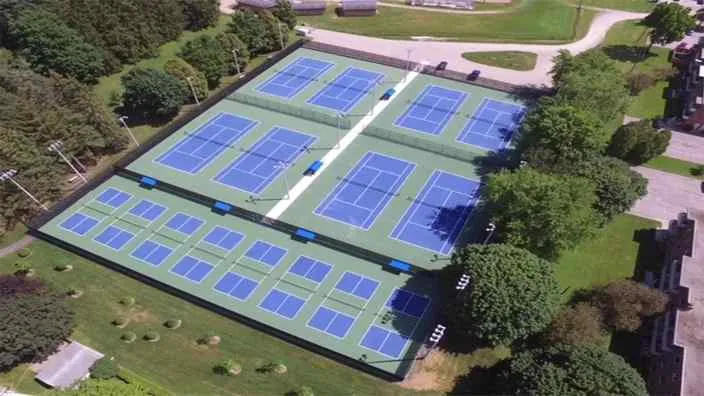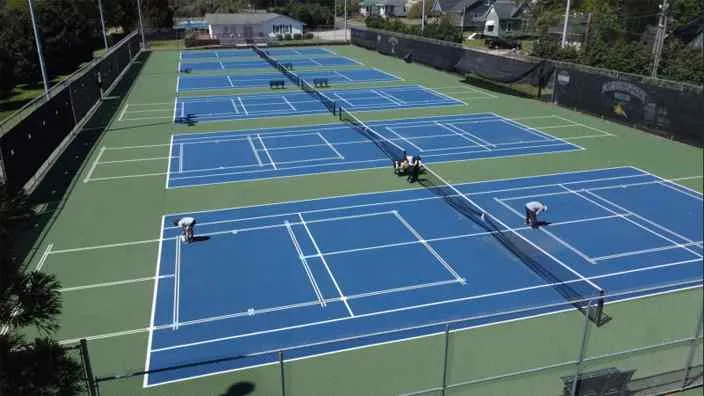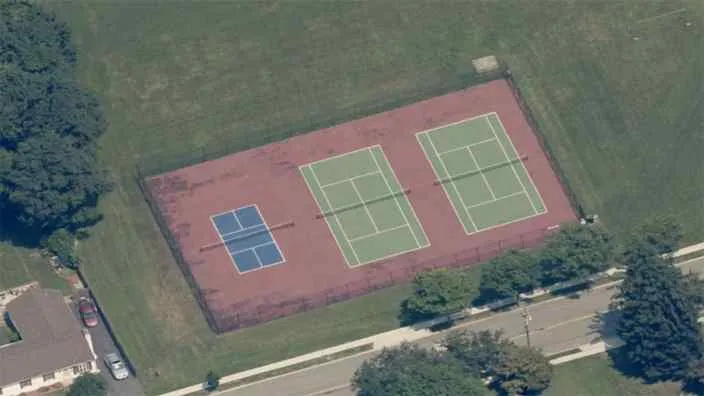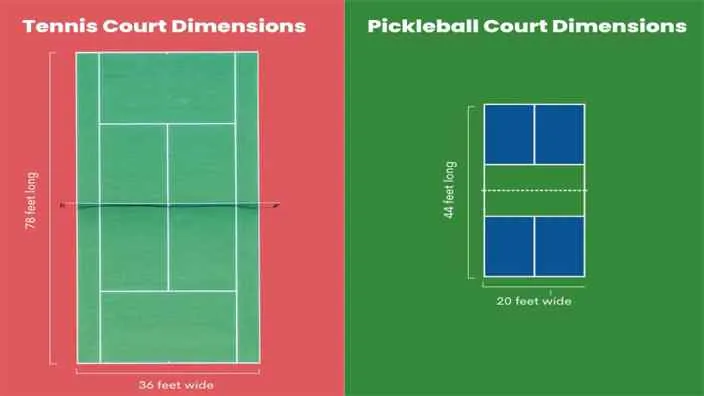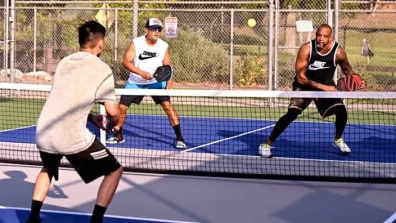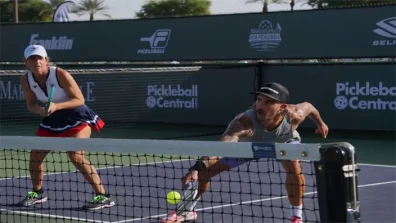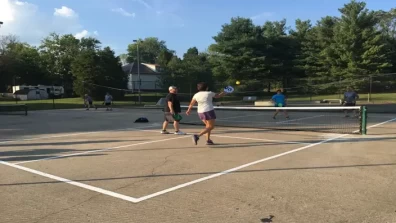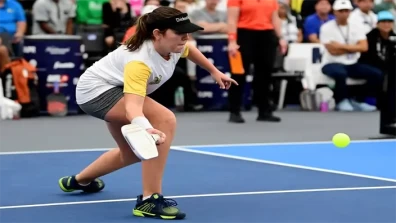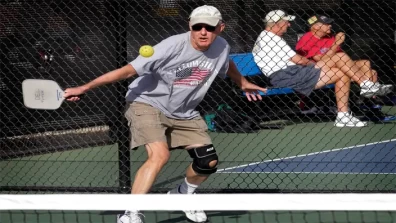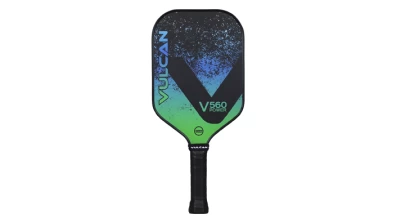Curious about the differences between pickleball and tennis courts? Or are you considering transforming a tennis court into a pickleball court? You’ve landed in the right place. In this article, we’ll compare pickleball court vs tennis court measurements and explain how the critical elements of each court impact gameplay. Besides, if you’re wondering about the costs and factors involved in converting a tennis court into a pickleball paradise, we’ll explain that, too. So, let’s dive in!
Table of Contents
Pickleball Court & Tennis Court Differences
The pickleball court differs from the tennis court in its size, service boxes, and net placement. There’s also a distinction between additional areas, center line and baseline measurements, and their usage in both courts. All these factors also impact the gameplay of both sports. Here’s a detailed look at the differences between both courts:
1- Court Dimensions
The pickleball court dimensions are always 20 feet wide and 44 feet long for both singles and doubles. But it needs to be at least 30 feet in width and 60 feet in length. However, it’s better to have a bit more space, around 34 feet by 64 feet, for the best experience. In contrast, a standard tennis court is 60 feet by 120 feet. Its playable area is 78 feet long and varies in width: 27 feet for singles and 36 feet for doubles. In total, a tennis court covers an area of 2,808 square feet.
2- Service Areas
There are service courts or areas in a pickleball where the ball needs to plop down when you serve. On each side of the court are two service areas, and a center line separates them. Each service area is like a 15x10 feet rectangle.
Now, in tennis, things are a bit different. There are four service boxes instead of service courts, two on each side of the net. And that’s where the tennis ball needs to hit when you serve. These service boxes are basically 21x13.5 feet rectangles.
3- Additional Areas
In a pickleball court, there’s an additional no-volley zone called the “Kitchen” that’s 7 feet wide on both sides of the net, and you can’t volley there. But in tennis, there’s an additional area called the doubles alley. It includes areas on each side of the court used in doubles matches, not singles. These alleys are 4.5 feet wide.
4- Serving
When you serve in a pickleball court, you stand behind the baseline and aim for the service court, but you can’t step into the 7-foot “kitchen” on the other side. In tennis, your serve goes diagonally from one side of the baseline to the service box on the opposite side of the net.
5- Net Height
There’s also a difference between picklball vs tennis net height. The net is shorter in the middle, at 34 inches in a pickleball court, and 36 inches high at the ends. This is a distinctive feature of pickleball. On the other hand, in tennis, the net is taller, measuring 3 feet (36 inches) in the middle and 3.5 feet (42 inches) at the ends.
6- Centre Line
The center line in a pickleball court splits the service courts into two halves, running from the kitchen to the baseline. This line is crucial in doubles, as it dictates that the server must serve diagonally, ensuring the ball lands in the receiver’s service court. In tennis, the center mark is a small mark on the baseline and doesn’t reach into the court like in pickleball. It’s there to help the server serve from one side of it to the opposite service box diagonally.
Discover More: Pickleball Shoes Vs. Tennis Shoes
7- Baseline
The Pickleball court has a baseline, part of the 20 by 44 feet court. That’s where you serve from, and your serve should hit the other service court. In comparison, in tennis, the baseline is within the larger court, which is 78 feet long by either 27 feet wide for singles or 36 feet wide for doubles. Like pickleball, tennis players serve from this baseline, but the twist is that the serve has to land in the diagonal service box opposite where the server stands.
8- Gameplay
Unlike tennis, Pickleball’s smaller court size emphasizes strategy over sheer power and speed. The “kitchen” area, or non-volley zone, is a unique feature that adds a strategic twist. Players can’t make direct shots (volleys) within this 7-foot area on both sides of the net. The service rules in pickleball also stand out. Servers must use an underhand serve, and the ball must bounce on each side before allowing volleys.
On the other hand, tennis is more physically demanding due to the larger court. Players often need to cover more ground and hit with more force. Moreover, tennis introduces strategic elements through its service boxes. Servers must serve diagonally to one of the two service boxes on the opposite side. In contrast to pickleball, tennis permits overhand serves and doesn’t require the ball to bounce before volleying.
Tennis Court To Pickleball Court Conversion
We discussed the distinctions between pickleball and tennis courts. Now, let’s consider the possibility of converting a tennis court into a pickleball court. Both tennis and pickleball are globally loved sports. Pickleball, blending elements from tennis, badminton, and table tennis, has surged in popularity. In the U.S., there were 4.8 million pickleball players in 2020. Globally, pickleball boasts 8.9 million players and over 36.5 million played it from August 2021 to August 2022.
On the other hand, tennis has around 1 billion fans. In the U.S., 3.82 million people participated in tennis as of September 2020. But as pickleball’s popularity soars, many tennis courts are being converted to meet the demand. Converting a tennis court into a pickleball court can be a budget-friendly solution to meet the rising demand for pickleball facilities.
The financial aspects of this conversion depend on the current tennis court's condition and local labor and material costs. Extra features such as seating or fencing can also impact the overall expenses. But on average, the cost to convert a tennis court to a pickleball court can range from $1,000 to $20K-$40K. For comparison, constructing a new pickleball court can cost between $20,000 and $50,000. The expense of resurfacing or converting a tennis court varies too.
Breakdown Of Costs Involved
- Resurfacing - If the existing tennis court is in a lousy shape, resurfacing might be necessary. This can cost between $4,000 to $10,800.
- Net Setup - Each pickleball court requires its own net, and you can find portable nets for $100 to $200 each.
- Line Marking - Since pickleball courts have different lines than tennis courts, you’ll need to paint new ones, which can run around $200 to $400 per court.
Now, with the possibility of converting a tennis court into a pickleball court and its cost answered, another question may arise in your mind. You might wonder, “How many pickleball courts fit on a tennis court?”
How Many Pickleball Courts Can Fit On A Tennis Court?
You can squeeze in 4 pickleball courts on a tennis court because pickleball courts are way smaller than tennis courts. A typical pickleball court is 20 feet by 44 feet, while a standard tennis court for doubles is 78 feet by 36 feet. To fit four pickleball courts, you’d line them up in two rows, and each court gets its own net. You can even adjust the tennis net to 34 inches in the middle and 36 inches at the ends to make it work.
But if you’d like more room around each court, you could just set up 2 pickleball courts on a tennis court instead of four. This will be beneficial if the tennis court needs to pull double duty for tennis and pickleball. In the case of two pickleball courts, each half of the tennis court would turn into a pickleball court. Here are the advantages and disadvantages of setting two pickleball courts on a tennis court:
Advantages
- Players have extra room to maneuver around each court.
- Smooth transition for dual-use with tennis and pickleball.
Disadvantages
- Fewer players can participate simultaneously compared to having four courts.
- Need extra nets for each pickleball court.
Frequently Asked Questions
How Can I Make A Pickleball Court Out Of A Tennis Court?
You can make two to four pickleball courts on a tennis court. A standard tennis court is 60 feet by 120 feet, while pickleball needs at least 30 feet in width and 60 feet in length. The actual playable area of a tennis court is 36 feet by 78 feet, whereas a pickleball court is smaller at 20 feet by 44 feet. You can use the same tennis net for playing pickleball but lower it by two inches in the center, making it 34 inches. And if you have permission, you can paint pickleball lines on the court, using a different color from the tennis lines.
What Type Of Court Is Pickleball Played On?
Pickleball is typically played on a rectangular court, akin to a doubles badminton court. The standard court size is 20 feet wide by 44 feet long, divided by a 34-inch-high net. These courts can be indoors or outdoors, with varying playing surfaces (like asphalt, concrete, wood, or synthetic materials). The court features distinct lines marking the baseline, service area, and non-volley zone, often called the “kitchen.” This non-volley zone has specific rules to prevent players from volleying the ball while standing within it.
Is Pickleball Louder Than Tennis?
In terms of noise, pickleball is usually seen as noisier than tennis. A sound level meter test shows that pickleball can reach up to 55 decibels, which is still under the EPA’s average outdoor noise limit of 55 decibels. In contrast, tennis registers at about 45 decibels.
Why Do People Like Pickleball More Than Tennis?
Lots of people like pickleball better than tennis for a few good reasons. First, it’s easier to get the hang of due to the smaller court and slower ball speed, making it a hit with beginners of all ages and skill levels.
Besides, it’s less physically demanding than tennis, perfect for those with physical limitations or who want a lower-impact game. But it’s not just about the game; pickleball is a social sport. The smaller court and slower pace often lead to longer rallies and more chit-chat between players, adding to the fun.
Which Is Harder On The Knees, Tennis Or Pickleball?
Both tennis and pickleball can be harder on the knees, but the impact varies depending on the person and how they play. Tennis often means more running and sideways moves, which can be hard on the knees. Besides, playing on hard courts can be tough on the joints. On the other hand, pickleball is generally easier on the knees but still involves movement that can affect them. The impact might be milder compared to tennis, especially if you’re on a softer court.
Conclusion
In the comparison of pickleball court vs tennis court, we’ve uncovered the key distinctions, conversion insights, and gameplay elements. Now, whether you’re a player, a court owner, or simply curious, you’re well-equipped to make informed decisions in the court of your choosing.

